Cindy
Sherman
The great American artist
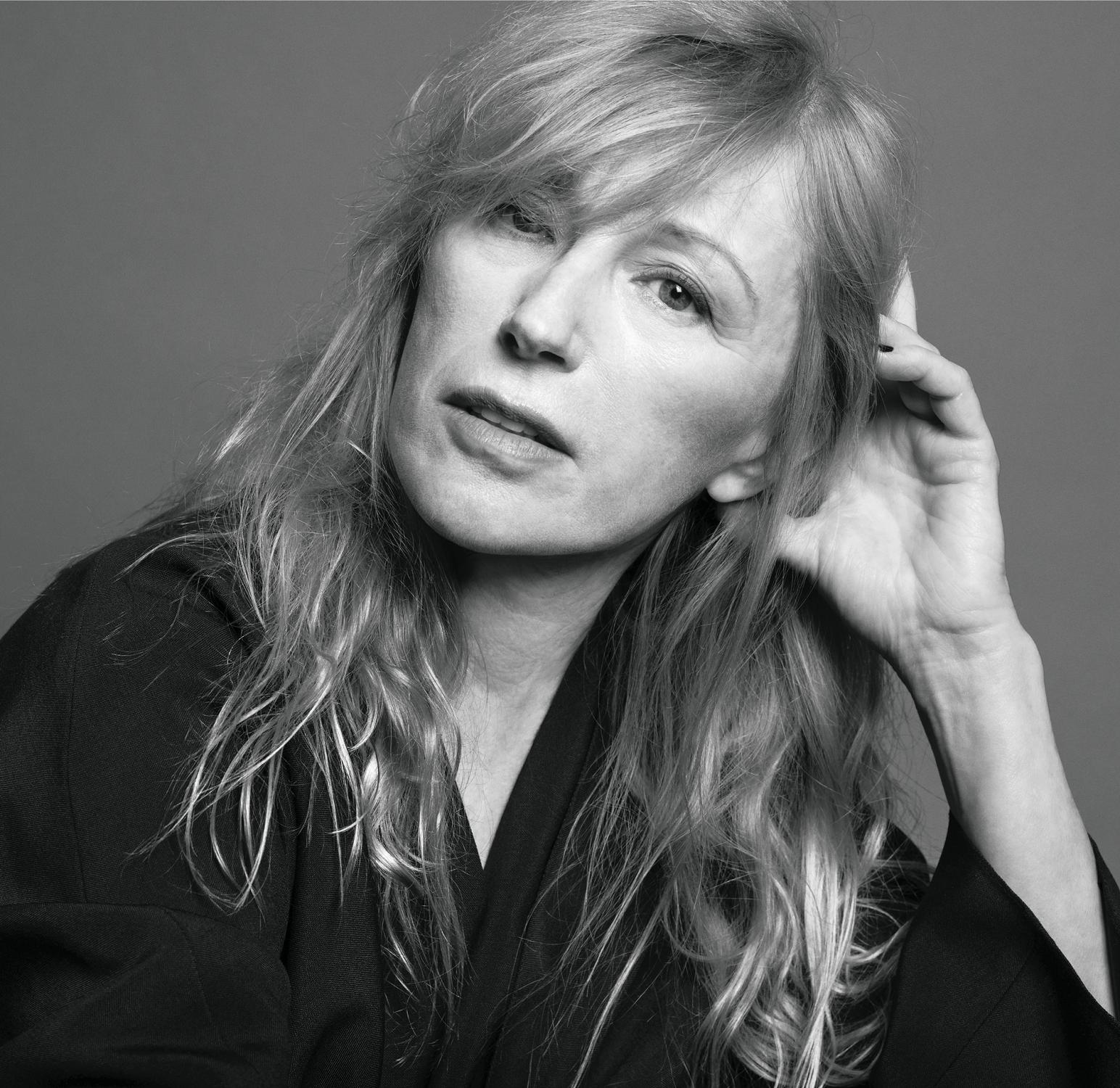
For almost 50 years, Cindy Sherman has been plundering her dressing-up box to turn herself into ingénues and society matrons, pin-ups and clowns – grotesquely familiar versions of the masks we all wear to face the world. She does this alone in her Hudson Square studio, surrounded only by the props – fake boobs, wigs, bits of mannequins – that help her create iconic images that contain not an ounce of Cindy Sherman.
But now, at 65, Cindy is moving into the picture, and with a huge survey show in London, she is celebrating what it means to age in front of the camera.
Cindy Sherman wears a beard. She shakes my hand. She says, “Nice to meet you,” and then, in a deeper, beard-befitting register, “Nice to meet you.” Her masculine spirit animal (as suggested by the photographers Inez and Vinoodh) is circa 1970s Werner Fassbinder, hair sweated into a greasy fringe, eyes lidded, cigarette in hand, coke in blood. We are at Inez and Vinoodh’s studio, a bright and unpretentious space in downtown Manhattan just west of the Bowery. Cindy, who is 65, sits on a stool, legs spread, her hands the most dangerous-looking thing about her. They grip her small knees and appear windburned. After a quick beard trim, the make-up artists glue eyebrows on to a face that has experienced a lot of glue. The eyebrows will later prove hard to remove, prompting Cindy to remark – possibly to ease the tension as two people nervously poke at her face with a tiny metal spatula – that she recently learned about a new procedure: eyebrow transplants. Where does the hair come from? someone asks. The back of the head, apparently. “But, you know,” Cindy says, “eyebrows are a different type of hair.” Among the many impressive stats Cindy Sherman boasts at this point in her life, the amount of glue she’s used over the course of her career has yet to be calculated.
Since her first exhibited series, the Untitled Film Stills, made between 1977 and 1980 – in which she photographed herself as an Everywoman film noir heroine (in a kitchen, on a deserted road), unaware that she’s about to be abducted/raped/murdered or just generally and brutally “disappeared” by the dominant cultural narrative – Cindy has photographed herself as a Renaissance lady, a society matron, a reclining centrefold, a clown, a bridge-and-tunnel party girl in her mid-40s, and thousands of other mostly female characters. Each of her images is named “Untitled #X,” leaving interpretation open to the viewer, but the series have acquired informal names: the Society Portraits, the Sex Pictures. Cindy is reluctant to discuss the meaning of her work, and, as the curator Darsie Alexander said in 2012, “The fact of her silence is now almost part of Cindy’s canon.” But no other contemporary artist has so relentlessly and obsessively (some might say – not even as a criticism – narrowly) interrogated how the self presents an external self and how the self learns the art of artifice. Paul Moorhouse, the curator of Cindy’s forthcoming show at the National Portrait Gallery in London, a survey of about 180 artworks that includes some never previously exhibited in a public space, attributes her ceaseless relevance to the fact that “she is really posing the question, What’s real? What’s artificial? How can we tell, and what meanings do we attach to all of these things?”
Right now, a team of nine people is, in fact, preparing Cindy to be Cindy as Cindy, perhaps the real Cindy, and the second of three characters she’ll embody (the third is Future Drag Cindy). Cindy-as-Cindy’s choice of outfit is black or white. She opts for black. Someone thought she was bringing her colourful macaw, Mister Frieda, to the shoot. She didn’t. “He’d be a big pain in the butt. He’d love the attention but would be very needy,” she says. Mister Frieda is 28 and Cindy has had him for 27 and a half years – for the first 10 he was Frieda, until Cindy discovered he was male. He has “many places where he hangs out” in her New York apartment and her house on Accabonac Harbor in East Hampton.
A neatly folded pile of clothes in the bathroom reveals what Cindy has shed. A Marni sweater. A pair of jeans. A smartwatch that, when accidentally knocked because it was in the way of a hand towel, lights up (it’s an Hermès Apple). The act of photographing Cindy as herself (or “herself”) pulls everything she’s ever been and done into a spin cycle of identity performance. Cindy, hunched in an oversized dress, hair gently scattered by a stylist waving what looks like a giant floor tile, might already be in drag. Self Drag. Or Self-Drag Drag. Or even Career Drag. Her face, though made-up, appears bare; she seems vaguely ill at ease trying to evoke herself, and only herself, for the camera. (In fact, her gallerist Janelle Reiring, tells me, Cindy had a blast; she loved learning, among other things, new techniques from the make-up artists.)
Inez says, “Wonderful face,” and “That’s a really good mouth.” Cindy responds with barely discernible micro facial movements that are totally transformative to her whole character. This transformation is not usually something that anyone witnesses. “I always work alone,” Cindy says, though she adds that she does have “a person for wigs. But that’s only for the past two years. She helped me with the men pictures and the series before that, the flapper girls.” Cindy moves her right hand as if she’s sketching the air with it. The hand itself appears sentient, a satellite brain exploring the space between her neck and hip, determining the best place to land. Composition matters, but character and story also matter. Who is this person, and where would their hand be?
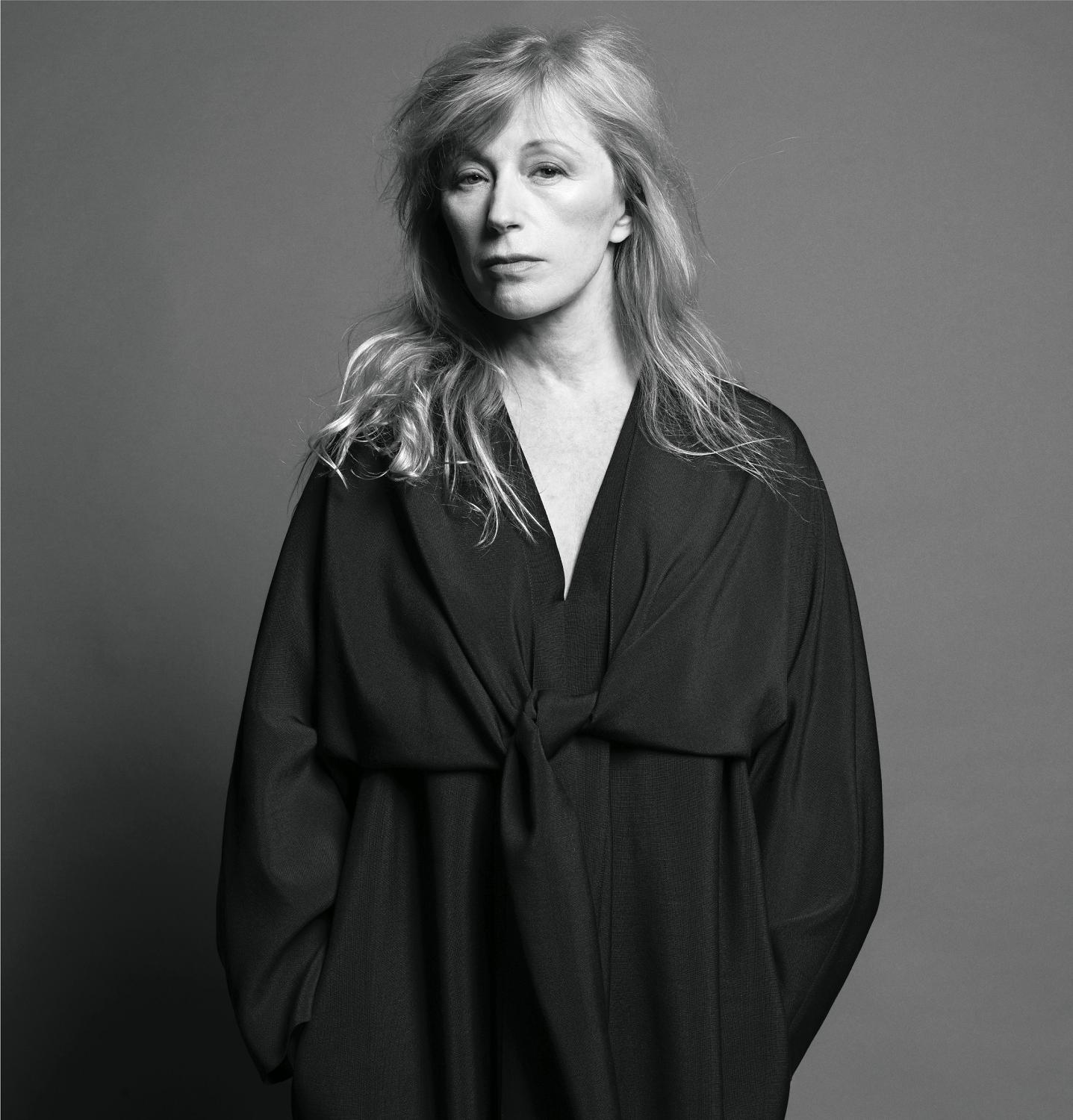
Look One
Cindy Sherman, as transformed by someone else for a change, sits for a series of portraits by Inez & Vinoodh for The Gentlewoman. Here and in the opening spread, she wears a navy wool-and-mohair dress by THE ROW.
Helene Winer, the co-founder with Reiring of Metro Pictures, Cindy’s sole gallery since 1980, thinks one reason for Cindy’s enduring appeal is her intuitive formal skills, which were immediately evident in the Untitled Film Stills. Other photographers couldn’t “quite believe” the high quality of Cindy’s work – they’d “ask about her equipment and her lighting and who helps her and all of those questions.” Yet, Winer insists, Cindy had no special camera, barely any assistance and very simple set-ups. Reiring adds that Cindy’s lack of photographic training and unwillingness to participate in critical debate are strengths. “She doesn’t get bogged down by, let’s say, traditional discourse.”
Mid-character-switch from Cindy-as-Cindy to Future Drag Cindy, lunch is served. Cindy chooses soup. She sits at the table alongside the manicurist, the stylist, the stylist’s assistant and the handful of other people whose purposes remain unclear. Cindy wears a white robe and terry towel slippers, her extravagant pink-and-black eye make-up covering half her face and resembling a bird mask. We talk about modes of transportation. Cindy prefers to cycle everywhere on her Pashley bicycle, even in the rain, but she has never cycled in a gown, and never in heels (only platforms). Her voice is calm, low and monotone. Her inch-long fake red nails make it difficult to hold her spoon.
“Because I’ve been taking pictures of myself all my life, I can really see the difference. Every little blemish, every little thing shows up.”
Cindy Sherman was born in the affluent suburb of Glen Ridge, New Jersey, in 1954, but her family moved to Huntington on New York’s Long Island when she was three. Her mother, who taught reading to children with learning difficulties, was, Cindy says, a very nice person – who in the 1970s became a born-again Christian. “She was speaking in tongues and all that,” Cindy says. Her father was an engineer who worked for the Grumman aircraft company. Cindy was the last of five children, nine years younger than her nearest sibling and 19 than her oldest. From a very early age, she exhibited a preternatural understanding of how visual language works and a single-mindedness about playing around with it. (She explains her predilection as the solution to a poignant lack; dressing up in costumes was the only way, as the youngest, she could get any attention.) “It’s been right there ever since she was a child,” Moorhouse says. “She used make-up and wigs to transform her own appearance, and then she started photographing herself, and that’s a really strange thing to do.”
At the age of 18, Cindy went to Buffalo State College. “I started out in the fine art department, majoring in painting,” she says, “but when I wanted to change my major to photography the dean told me I obviously wasn’t committed enough or didn’t know what I wanted, so they demoted me to the general arts department.”
She told The New York Times in 1996, “There was nothing more to say through painting. I was meticulously copying other art, and then I realised I could just use a camera and put my time into an idea instead.” She refers to an assignment from 1975 (“Untitled #479”, a grid of 23 black-and-white contact photographs captured as if in a photo booth) as her “first serious work”. In a conversation with Eva Respini, the curator of New York’s Museum of Modern Art 2012 retrospective, Cindy said, “I did this transitional series, from no make-up to me looking like a completely different person. The piece got all this feedback; it dawned on me that I’d hit on something.”
In late 1974, Charles Clough and Robert Longo, then Cindy’s boyfriend and a fellow student, opened Hallwalls in a converted ice-packing warehouse in Buffalo. The artist-run gallery was modelled on Artists Space, a non-profit venue in Manhattan that had opened in 1972. The goal was to exhibit local artists and coordinate exchanges with artists from other cities. Hallwalls quickly developed an international reputation as an influential gallery specialising in innovative work. It put on Cindy’s first solo exhibition, A Play of Selves, in 1976. The Buffalo Courier-Express declared, “Viewers will be dazed by the depth of [Sherman’s] talents.”
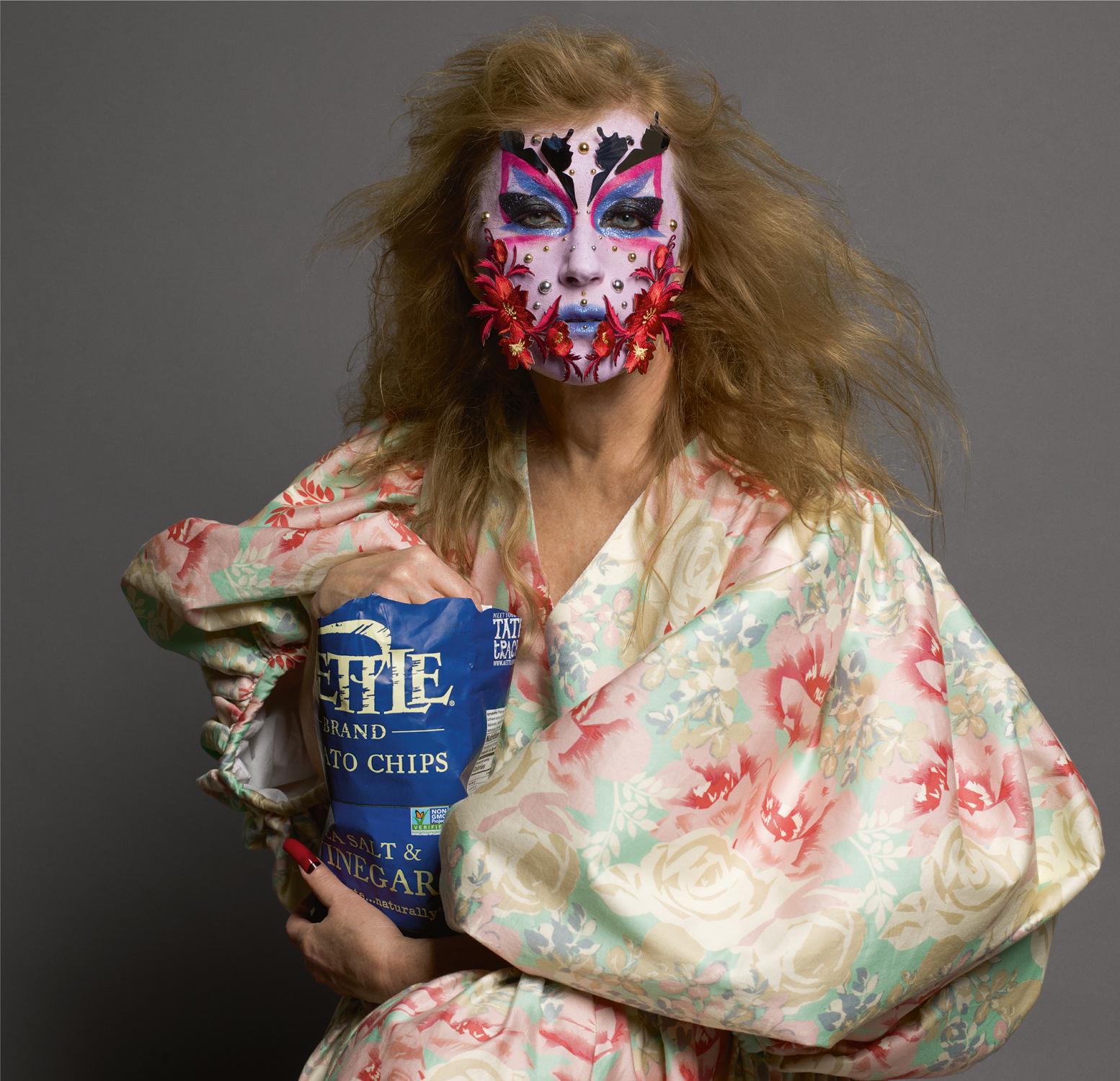
Look Two
Here and in the final image, Cindy is wearing a voluminous pink, green and ivory cotton floral-print full-length dress by VAQUERA.
The artist Laurie Simmons remembers Cindy at Artists Space. “I was bringing in a box of my small doll house interiors in preparation for my first New York show,” she tells me by email. “Cindy asked if she could see my pictures and then pulled a box of her black-and-white Untitled Film Stills from the drawer. One of us cracked a joke, something like, I’ll show you mine if you show me yours. That’s how our friendship began.”
In 1980, as part of a group exhibition at the newly opened Metro Pictures gallery, Cindy showed some of these Untitled Film Stills, meant, she said, to represent one actress at various points in her career. She told Art News in 1983, “Once I’m set up, the camera starts clicking, then I just start to move and watch how I move in the mirror. It’s not like I’m method acting or anything. I don’t feel that I am that person… I may be thinking about a certain story or situation, but I don’t become her. There’s this distance. The image in the mirror becomes her – the image the camera gets on the film. And the one thing I’ve always known is that the camera lies.”
The Untitled Film Stills exerted an enigmatic power; the images were so familiar and yet not. They were unsettling, oblique and impossible to forget. Many Sherman fans can still cite the first time they saw one. I remember when I did. It was 1988. I was in college, in New Hampshire, in a bulky sweater, in a mood, in the dark, in a women’s studies class. Suddenly on the classroom screen a wrathful woman in a face-obscuring blond wig and black skirt suit appeared. Her arms were rigid and her fists were clenched, her hair parted just enough to reveal a single, bloodshot eyeball. Were I to pinpoint the moment I first thought “I might have a subtext”, this would be it.
The Untitled Film Stills remain one of the most significant bodies of work made in the 20th century. Eva Respini says that it is “difficult to divorce the Untitled Film Stills from the mountain of critical writing they have stimulated, in which they are cited to illustrate postmodernism, feminism, psychoanalytic theories of the male gaze and the culture of the spectacle.” (The show’s catalogue also includes a photograph of Cindy and a friend, Janet Zink, aged about 11, dressed and made up to look like old women.)
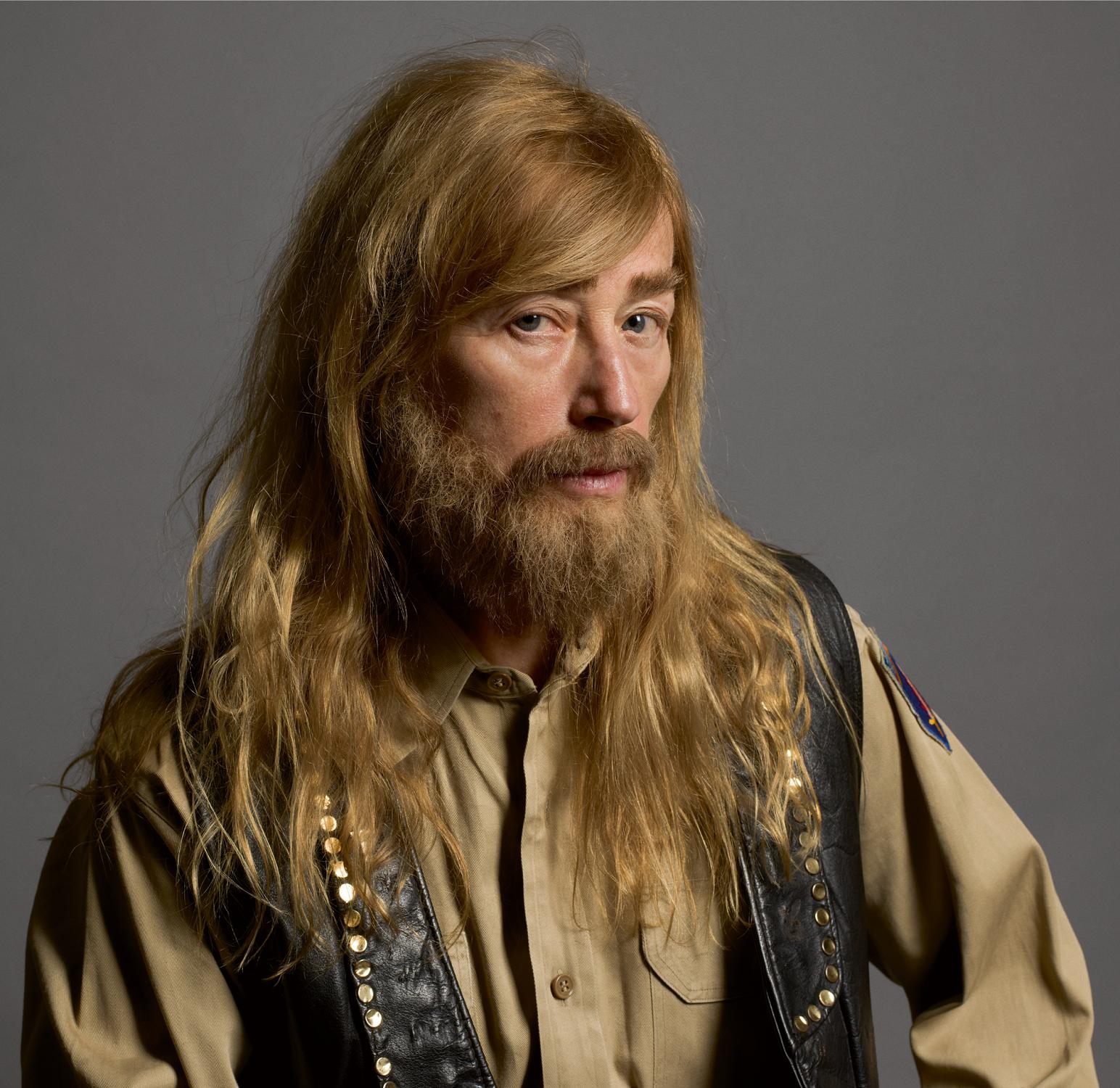
Look Three
Cindy is wearing a vintage khaki cotton shirt from Search & Destroy. The vintage studded leather vest is by Schott, from Southpaw Vintage.
“In the 1980s, male painters were getting so much money! Then the market crashed and I didn’t suffer as much as they did.”
Over the ensuing four decades, Cindy has continued to play at the boundaries of beauty and ugliness, splendour and revulsion, critique and collusion. In the Centrefolds series in 1981 she appeared in colour for the first time: as a wide-eyed woman confronting her implied killer (the camera lens, us); as a newly dead corpse, eyes still wide, face speckled with dirt; and as a body unnaturally contorted and dressed like a 1950s schoolgirl, hand gripping a crumpled personal ad like a clue. That last photograph, “Untitled #96”, became the most expensive ever when in 2011 it sold at Christie’s New York for $3,890,500, double its estimate.
Cindy says she created the Disasters series (1987–89) as a cheeky rejoinder to her sudden popularity. The exuberantly repellent images, while compositionally beautiful, with sumptuous colours, look as if they have been snapped at the scene of a murder committed at a local dump, featuring rubbish, vomit, pimpled body prosthetics, naked dolls forced into pornographic positions and rotting food. The series was, she says, a response to the bawdy lionising of artists such as Julian Schnabel and David Salle, and to what Cindy saw as an opportunistic, status-grabbing trend among artists, gallerists and collectors. “I noticed in the 1980s, the first wave of the hyped art market, that a group of male painters were getting so much money compared to everybody else in the art world,” Cindy tells me, “and I was feeling, ‘Well, I’m getting equal, if not better, press,’ and I’d feel like, ‘That’s so unfair!’ But then the 1980s crashed, and a lot of them were out of favour for a long time. And I luckily sort of just stayed where I was and didn’t suffer as much as they did.” Her works continue to command seven-figure sums.
Cindy has received almost every award going, including a MacArthur Fellowship (known as the “genius grant”), the prestigious Praemium Imperiale in 2016 and, just this year, the triennial Max Beckmann Prize for outstanding achievement. She has exhibited three times at the Venice Biennale and in 2013 was asked to curate a show there. That same year, she received an honorary doctorate from the Royal College of Art. Cindy’s first solo show in China closed last month.
A week after seeing Cindy in a dressing gown eating soup, I am at her ninth-floor Hudson Square loft, two blocks from the Hudson River. Cindy’s sweater is soft and deer-coloured. Her trousers are technical and green. Her shoes are beige platform brogues. Cindy was married to the video artist Michel Auder for nearly 15 years, until 1999, and has been linked with Richard Prince, Steve Martin and David Byrne, but now lives alone – or, as she likes to say, “with my bird”.
Her two-storey loft is vast and sunny, with single-pane windows that seem small and abstemious compared to the lunatic glass cliffs all over Lower Manhattan. Hers parcel psychically manageable views to the west, south and north. Wigs on styrofoam heads neatly line the windowsills. On an otherwise blank strip of wall between windows is what looks to be a silicone breast implant, affixed like a sculpture. It might also be a sculpture. Cindy buys many of her props – the breasts, the buttocks, the noses – from Gordon Novelty on 29th Street. She tells me she spends money on art, mostly by younger artists. One of her most prized possessions is a book by the German artist Hans Bellmer, known for his artwork involving dolls and doll parts posed in recombinatory, sculptural configurations. “The pages are actual photographs, so it is really beautiful,” Cindy says. It is fitting that Cindy would splurge on a Bellmer book; the relationship between her pictures and Bellmer’s poupées of the mid-1930s has long been discussed.
Many different work tables, some with multiple computer screens, are pushed against the workspace perimeter. A quasi-photo studio – a blank backdrop and a tripod – occupies the northern edge. Magazine pages and colour printouts are taped to the walls in slightly overlapping grids. The images might have been used as inspiration for the Flapper series, in which Cindy turned herself into veteran film stars from Hollywood’s Golden Age – Lillian Gish, say, or Gloria Swanson. Amid the photos of actresses and their overall vibe of lost silver-screen glamour is a peppy Allure cover of Jennifer Aniston.
There’s a central desk, like command control, with a swivel chair. On one of the computer monitors are images from a new series (she’s still perfecting these). “What I do worry about is trying to think of something new. What’s next? What else can I do? I’m concerned about not trying to repeat myself and still trying to find things that culturally I want to address.” This series was originally shot for Harper’s Bazaar in New York in 2016 and will be shown for the first time at the National Portrait Gallery’s retrospective in June. In a single photograph, she might appear three or four times as different personas wearing different outfits by Marc Jacobs, Gucci, Prada, among others. The characters, Cindy tells me, are inspired by women on their way to a fashion show – in particular, the ones who get out of their cars a few blocks from the venue so they can be photographed on the street. “They want to be like, ‘Look at me,’” Cindy says. “Some of them even do little dances. Twirling around. It just seems kind of ridiculous.”
Cindy offers tea. She disappears through a hallway that also might be a kitchen, lined with glossy cabinets, and that leads to her living space. The whole loft is the shape of a fat H. Cindy returns with a round silver teapot and two blue-and-green glazed ceramic shot glasses. Behind us hangs a pair of giant tapestries, each featuring the same image of Cindy from her Instagram feed.
She only joined Instagram on 12 October 2016, with a post from Kill Bill restaurant in Tokyo. “I was going to Japan with a friend,” she tells me as she settles back into the office chair, “and she was on Instagram, so I thought, ‘I’ll post from my trip, too. Why not?’ At that point, the account was private. But whenever someone requested to follow me, I felt it was my duty to see if they were really serious art-interested people. So I’d look up their Instagram and see, ‘Ah, OK, they look like they’re creative enough.’ Some people would be posting a bunch of selfies in the mirror, so those people I’d reject. But I just found it was taking up too much time to be researching who wants to follow me, so that’s when I went public, about five months into it.”
Cindy’s Instagram persona might be that of just another celebrity dropping breadcrumb trails through her daily life – a Shanghai skyline, a plate of hospital food – except that she erratically punctuates banal moments with Sherman-style moments of performance, manipulated using new technologies. Her colourist introduced her to Facetune. “I downloaded the app, and that night I was playing with it to make myself look weird,” she says. “I just kept trying the different things it could do to change my skin texture and use all of the tools that other people used to look good.”
“I’ll think, If I just tweak the character like this or that I’ll have an entirely different character.”
In the “old” days before digital photography, Cindy’s work was necessarily shaped – or limited – by the available technology. She took test Polaroids – “they were the size of a slide, because I was shooting on slide film” – but it was hard to tell if the colours were right. “I would shoot something, do all the make-up, take all the make-up off, and bring the film to the lab and then come back a couple of hours later and find out that it was all out of focus, or something was off, like the background didn’t look good.” Now, she says, she shoots in front of a green screen. “I use a head that’s on a tripod to stand in for me to figure out how zoomed in I’m going to be, and I can focus on that and, digitally, I can just do a bunch of tests and see what works.” She adds, “There’s so much that I can adjust now. It’s really exciting to have that much control. And I’ll think, ‘If I just tweak the character like this or that, I’ll have an entirely different character,’ so then I’ll shoot a whole second image that same night.”
Cindy has long played around with the ageing process in her work. But, she tells me, cosmetic surgery, or rather doing things cosmetically to improve or fix things as you age, is beginning to affect her. “Because I’ve been taking pictures of myself all my life, I can really see the difference – and now, digitally, every little blemish, every little thing shows up. It is a balancing act.” She has had Botox in the past. “But when I’m working I don’t want a frozen eyebrow. I want to be able to move my forehead around and make expressions. So maybe now I can do some Botox… Still, I haven’t done it for a year, and I’ve been thinking, Should I? Maybe I shouldn’t?”
This real-life modification, twistily, hampers her ability to modify herself in art that uses, as its canvas, her modified self. And having witnessed, at her photo shoot, the global effect of the tiniest facial movement, it follows that she needs her face’s full range of chords.
Cindy pauses. “It crossed my mind, starting this interview: do I really want to reveal this? I did have my neck done about a year and a half ago.” She has never hidden this. “My gallery, my assistant, my family… If people were talking about plastic surgery, I’d say, ‘Yeah, I’ve had my neck done.’ But, yes, we don’t talk about it, and I think there is a stigma.”
She lifts her chin, exposing her neck. She pushes the skin around like clay she’s shaping with her fingers. “The last show I did, the Flappers, with many of them we did tweak the neck. I didn’t want it completely smooth, but I thought it looked really bad. So I suddenly succumbed, I guess you could say. I’m really happy with it, though. I still think I have a wrinkly neck in certain lighting.” She pauses again. She recants, or at least rethinks. “In some ways, I let down, maybe, some generation of women. Maybe I should have just let the neck run its natural course.”
When Cindy worries about letting people down, she’s possibly worrying about her responsibility as a role model. Janelle Reiring remembers a panel at MoMA in 2012 in which the painter Elizabeth Peyton identified Cindy’s importance. “She said, ‘What really influences me is the way she has chosen to lead her life as a woman artist.’” Laurie Simmons tells me she and Cindy are part of a gang of old friends connected to the arts, loosely called Film Group. “Yes, we discuss films but it’s more like ‘Life Group’. We’ve experienced loss, sadness, divorce, but it’s also a place to unselfconsciously share our successes, good news, birthdays. Probably a lot like an old-fashioned sewing circle or flower club – with raunchier talk and more heated political conversations.”
“I’m concerned about still trying to find things that culturally I want to address.”
When Cindy was growing up on Long Island, the only women artists she knew were the two – Mary Cassatt and Judith Leyster – who featured in the sole book on art in the house, 100 of the World’s Most Beautiful Paintings, published by Time-Life Books. The family never travelled to New York to visit museums or galleries; they went just to see the Rockettes at Radio City Music Hall. “Otherwise we never went into the city,” Cindy says.
I ask her to describe her childhood bedroom; she can’t summon much but does remember “a little plaque with five hooks on it for each of the weekdays, and then making little drawings of the outfits that I had in mind to figure out what I was going to wear to school for the whole week. I didn’t want to wear the same thing twice in one week. I had this teacher in math that I was really impressed with because it seemed as if she never would wear the same outfit twice. So I made this little thing where I had made drawings of all my little skirts and dresses.”
This memory triggers another, of a film she made almost 50 years ago that will feature in the show at the National Portrait Gallery. “When I was in college I wound up making a replica of that idea, only it was paper dolls, because I also played with paper dolls when I was a kid. So I shot myself in my underwear, and I then shot all of my clothes, and I made this book and had the categories – skirts, tops, casual, jackets – and then there were these pockets with little clothing, and they had the tabs so that you could actually put it on the little body I cut out of myself. And eventually that turned into a little film. I made an animation where this doll comes out of the box and kind of walks around and tries on clothes. And then this big hand, which is me, comes in to grab her and she screams and the hand puts her back in the box. It’s a really goofy little film.”
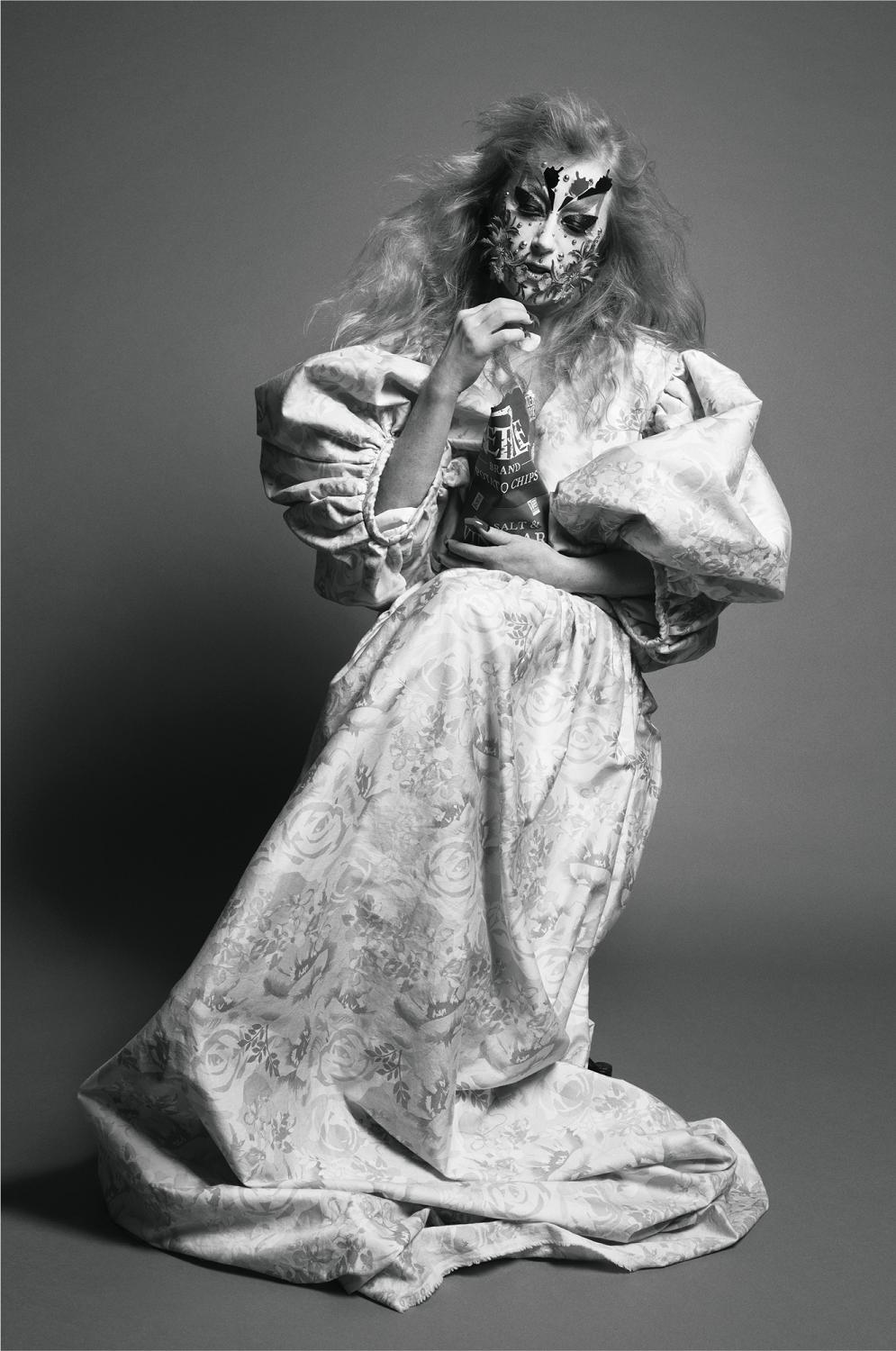
Cindy Sherman was photographed in New York City on 6 December 2018.
Heidi JulavitsA native of Portland, Maine, Heidi Julavits is an award-winning writer and editor, best known for her acclaimed novels, The Vanishers, The Uses of Enchantment and The Effect of Living Backwards, and the best-selling anthology Women in Clothes. Her work is regularly published in Harper's, The New York…read more Portraits by
Inez & VinoodhInez van Lamsweerde and Vinoodh Matadin are, quite simply, the world’s most in-demand fashion photographers. Since 1986, the Dutch duo have worked together, creating a vast back catalogue of fashion’s most arresting images – as illustrated by their 2012 tome Pretty Much Everything. Their unique…read more
Styling: Sydney Rose Thomas. Hair: Rutger at The Wall Group. Make-up: Ryan Burke at Kreative Kommune using KETT COSMETICS. Manicure: Gina Viviano at Tracey Mattingly using CHANEL Beauty. Photographic assistance: Joe Hume. Make-up assistance: Shelia McKenna. Production: VLM Productions. Post-production by StereoHorse.
This profile was originally published in The Gentlewoman nº 19, Spring & Summer 2019.